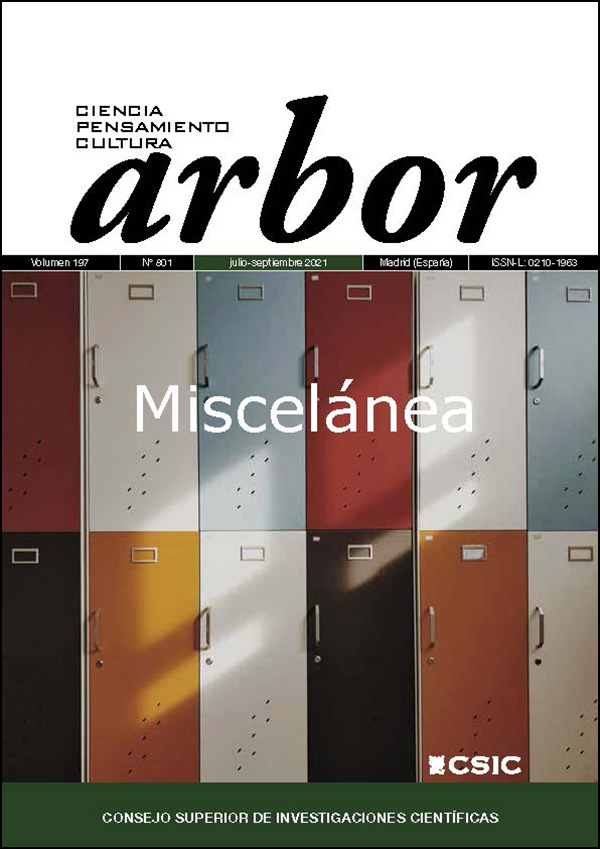The «cut» as an operative concept of permanence in art, architecture and built heritage. Light, space, matter and memory
DOI:
https://doi.org/10.3989/arbor.2021.801006Keywords:
“cut”, permanence, light, space, matter, memory, landscape, horizon, placeAbstract
Artistic and architectural ideation is, to a large extent, configured from a concept or metaphor that rules over our designs as a synthesis of our thinking and which later is confronted with the place, thereby creating a certain tension between landscape and intervention of the project.
This article explores Sverre Fehn’s concept of the “cut”, taken as a symbolic element of resistance linked to time, place, and memory as a generative idea, based on conceptual analogies applied in his projects.
Thus, a simple gesture, a crack, a cleft, or even a void in the ground is taken as a memory that somehow configures the idea of the place we travel through with our gaze, and refers us to the testimony of another time as we experience it in permanent dialogue with the landscape in which it is inscribed, creating an intense relationship between light, space, matter, and memory, with the landscape horizon as the limit of the work.
This article takes a tour through different artistic, architectural and even heritage works. Their common denominator is the concept of “cut”, an element of permanence that facilitates an integrating reading from the project, in an attempt to cross and even link the language used between disciplines in order to dilute borders, cross boundaries, recover memory and establish, as Rosalind Krauss (1985) would say, a new “expanded territory”.
Downloads
References
Andrew Dickson White Museum of Art (1969). Earth art. Ithaca, Nueva York: Office of University Publications Cornell University.
Casanova, Maria y Matta-Clark, Gordon (1993). Gordon Matta-Clark. Valencia: IVAM Centre Julio González.
Celant, Germano y Heizer, Michael (1996). Michael Heizer [published on the occasion of the exhibition held at Fondazione Prada of Milan, 15 December 1996-31 January 1997]. Milan: Fondazione Prada.
Chester, Alicia (2013). Bunker 599: A Photographic Monument. Disponible en: https://www.academia.edu/5681968/Bunker_599_A_Photographic_Monument.
Decter, Joshua (1991). Gordon Matta-Clark. Arts Magazine, 65(2): 103-105.
Fehn, Sverre (1999). Sverre Fehn : above and below the horizon. Tokio: A+U Archit. Urban.
Fehn, Sverre y Hopkins, Michael (1997). The skin, the cut, & the bandage. En: Anderson, S. (ed.). The Pietro Belluschi Lectures. Cambridge, Massachusetts: School of Architecture and Planning, Massachusetts Institute of Technology, pp. 1-37 / 72.
Heidegger, Martin; Leyte Coello, Arturo y Adrián, Jesús (2015). Construir, habitar, pensar = Bauen, Wohnen, Denken. Madrid: La Oficina ediciones.
Heizer, Michael, (1969). Artforum. 8 (4): 32-39. https://doi.org/10.2307/3191331
Kahn, Louis I. (2003). Forma y diseño. Buenos Aires: Nueva Visión.
Krauss, Rosalind (1985). La escultura en el campo expandido. En: Jean Baudrillard, Jürgen Habermas, Edward Said y otros: La Posmodernidad. Barcelona: Kairós, pp. 59-74.
Lavalou, Armelle (1993). Au pays des lumières horizontales, un entretien avec Sverre Fehn. L'Architecture d'aujourd'hui. 287: 80-124.
Lee, Pamela M. (2000). Objetos impropios de la modernidad. En: Darío Corbeira. Construir... o Deconstruir? : Textos Sobre Gordon Matta-Clark. Salamanca: Ediciones Universidad de Salamanca, pp. 91-132.
Maderuelo, Javier (1990). El espacio raptado: interferencias entre arquitectura y escultura. Madrid: Mondadori España.
Martínez García-Posada, Ángel (2009). Sueños y polvo: cuentos de tiempo sobre arte y arquitectura. Madrid: Lampreave.
Matta-Clark, Gordon y Moure, Gloria (2006). Gordon Matta-Clark. Madrid: Museo Nacional Centro de Arte Reina Sofía.
Millán Gómez, Antonio (2018a). Sentidos de Sverre Fehn: ver, anotar, diseñar. EGA Expresión Gráfica Arquitectónica, 23 (34): 134-147. https://doi.org/10.4995/ega.2018.10864
Millán Gómez, Antonio (2018b). Sverre Fehn: el lugar como soporte. Revista proyecto, progreso, arquitectura, 19: 16-35. https://doi.org/10.12795/ppa.2018.i19.01
Norberg-Schulz, Christian y Postiglione, Gennaro (1997). Sverre Fehn : works, projects, writings, 1949-1996. New York: The Monacelli Press.
Norri, Marja-Riitta y Kärkkäinen, Maija (1992). Sverre Fehn: the poetry of the straight line. Helsinki: Museum of Finnish Architecture.
Per Olaf, Fjeld y Fehn, Sverre (2009). Sverre Fehn : the pattern of thoughts. New York: Monacelli Press.
Pincus-Witten, Robert y Corbeira, Dario (2000). Construir… o deconstruir? : textos sobre Gordon Matta-Clark. Salamanca: Ediciones Universidad de Salamanca.
Prada Pérez de Azpeitia, Manuel de (2002). Componer con vacío. Notas sobre la configuración del vacio en el arte y la arquitectura. Cuaderno de Notas: 57-84.
Rincón Borrego, Iván Israel (2014). "The Skin, the Cut, the Bandage". Legado y crítica en Sverre Fehn. En: Critic|all, I International Conference on Architectural Design & Criticism. Madrid: ARKRIT Grupo de Investigación de Crítica Arquitectónica, pp. 11-13.
Saramago, José (2002). Cuadernos de Lanzarote: (1993-1995). Barcelona: Círculo de Lectores.
Siza, Alvaro; Domingo Santos, Juan; Márquez Cecilia, Fernando y Levene, Richard (2008). Alvaro Siza, 2001-2008 : el sentido de las cosas = the meaning of things. Madrid: El Croquis Editorial.
Steen, Henrik (1997). An interview with the Norwegian architect. Living Architecture Scandinavia Design, 15: 211.
Tallón Iglesias, José Antonio (2015). Gordon Matta-Clark a través de Rem Koolhaas : Adición a través de eliminación, [Tesis Doctoral Inédita]. Madrid: Universidad Politécnica de Madrid: Departamento de proyectos arquitectónicos. Disponible en: https://dialnet.unirioja.es/servlet/tesis?codigo=119414.
Tiberghien, Gilles A. (2012). Land Art. París: Carré.
Tufnell, Ben (2006). Land art. London: Tate Publishing.
Wall, Donald (1976). Gordon Matta-Clarks's building dissections. Arts Magazine, 50: 74-79.
Published
How to Cite
Issue
Section
License
Copyright (c) 2021 Consejo Superior de Investigaciones Científicas (CSIC)

This work is licensed under a Creative Commons Attribution 4.0 International License.
© CSIC. Manuscripts published in both the printed and online versions of this Journal are the property of Consejo Superior de Investigaciones Científicas, and quoting this source is a requirement for any partial or full reproduction.
All contents of this electronic edition, except where otherwise noted, are distributed under a “Creative Commons Attribution 4.0 International” (CC BY 4.0) License. You may read the basic information and the legal text of the license. The indication of the CC BY 4.0 License must be expressly stated in this way when necessary.
Self-archiving in repositories, personal webpages or similar, of any version other than the published by the Editor, is not allowed.














